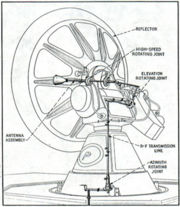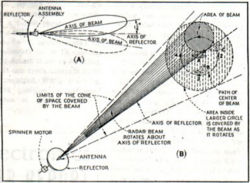SCR-584 Technical Description
| Revision as of 00:59, 28 February 2008 (edit) Paul (Talk | contribs) ← Previous diff |
Revision as of 02:41, 28 February 2008 (edit) Paul (Talk | contribs) Next diff → |
||
| Line 1: | Line 1: | ||
| '''Back to''' [[VERLORT Radar|Verlort Radar]] | '''Back to''' [[VERLORT Radar|Verlort Radar]] | ||
| - | <BR><BR> | + | <BR> |
| + | |||
| + | ---- | ||
| + | |||
| + | These notes have been prepared by '''''Ken Anderson''''', one time AN-FPQ6 radar supervisor at the Carnarvon Tracking Station supplemented (in italics) by '''''Paul Dench'''''. | ||
| + | |||
| + | ---- | ||
| + | |||
| The SCR-584, development of which began in 1941, could be operated in either a search or track mode. In the search mode the antenna was rotated through 360 degrees at 6 RPM. On each revolution the antenna elevation is raised so that it reaches a maximum elevation of 20 degrees in one minute. The result is a complete helical search of the space surrounding the radar. | The SCR-584, development of which began in 1941, could be operated in either a search or track mode. In the search mode the antenna was rotated through 360 degrees at 6 RPM. On each revolution the antenna elevation is raised so that it reaches a maximum elevation of 20 degrees in one minute. The result is a complete helical search of the space surrounding the radar. | ||
| Line 6: | Line 13: | ||
| [[Image:Helical scan.jpg|right|thumbnail|180px|Helical scan mechanism:<BR>''Image – ‘Electronics’; Fig 2, Dec ’45, p.104'']] | [[Image:Helical scan.jpg|right|thumbnail|180px|Helical scan mechanism:<BR>''Image – ‘Electronics’; Fig 2, Dec ’45, p.104'']] | ||
| + | [[Image:Conical beam.jpg|left|thumbnail|250px|A conical scan beam:<BR> ''Image – ‘Electronics’; Fig 1, Nov ’45, p.104'']] | ||
| So we have three different scan patterns of associated with the antenna: | So we have three different scan patterns of associated with the antenna: | ||
| Line 12: | Line 20: | ||
| '''(b)''' a '''spiral scan''' in which the antenna is caused to spiral outwards from a designated azimuth and elevation and then back to the designated position until a particular target is located. This would be limited in extent, probably only 1 or 2 degrees maximum; and | '''(b)''' a '''spiral scan''' in which the antenna is caused to spiral outwards from a designated azimuth and elevation and then back to the designated position until a particular target is located. This would be limited in extent, probably only 1 or 2 degrees maximum; and | ||
| - | [[Image:Conical beam.jpg|left|thumbnail|250px|A conical scan beam:<BR> ''Image – ‘Electronics’; Fig 1, Nov ’45, p.104'']] | ||
| '''(c)''' the rotation of the beam around the bore sight line of the antenna so as to provide a '''conical beam pattern''' (see diagram to the left) which allows the system to automatically determine the position of, and automatically track, the target. | '''(c)''' the rotation of the beam around the bore sight line of the antenna so as to provide a '''conical beam pattern''' (see diagram to the left) which allows the system to automatically determine the position of, and automatically track, the target. | ||
| - | + | ||
| + | ''Where there was more uncertainty about the target path, a '''nutating''' mode was used (see diagram to below left) where the slightly offset dipole feed was rotated rapidly to produce off-axis radiation increasing the effective beam width from 2.5° to about 5.5° . Nutation was switched off when the target was acquired.'' | ||
| + | [[Image:offset dipole.jpg|left|thumbnail|290px|Nutating antenna dipole feed:<BR>''Image – ‘Electronics’; Fig 5, Dec ’45, p.107'']] | ||
| + | |||
| Having located the target in angles the fine range display would then be used to differentiate between, for example a friendly fighter and enemy bomber and then allow the operator initiate automatic tracking of that target. | Having located the target in angles the fine range display would then be used to differentiate between, for example a friendly fighter and enemy bomber and then allow the operator initiate automatic tracking of that target. | ||
| Line 26: | Line 36: | ||
| See: http://www.fas.org/man/dod-101/navy/docs/es310/trksys/trksys.htm for an explanation of the principles of '''Tracking Systems'''. | See: http://www.fas.org/man/dod-101/navy/docs/es310/trksys/trksys.htm for an explanation of the principles of '''Tracking Systems'''. | ||
| - | |||
| - | [[Image:offset dipole.jpg|right|thumbnail|290px|Nutating antenna dipole feed:<BR>''Image – ‘Electronics’; Fig 5, Dec ’45, p.107'']] | ||
| - | |||
| - | ---- | ||
| - | |||
| - | These notes have been prepared by '''''Ken Anderson''''', one time AN-FPQ6 radar supervisor at the Carnarvon Tracking Station | ||
Revision as of 02:41, 28 February 2008
Back to Verlort Radar
These notes have been prepared by Ken Anderson, one time AN-FPQ6 radar supervisor at the Carnarvon Tracking Station supplemented (in italics) by Paul Dench.
The SCR-584, development of which began in 1941, could be operated in either a search or track mode. In the search mode the antenna was rotated through 360 degrees at 6 RPM. On each revolution the antenna elevation is raised so that it reaches a maximum elevation of 20 degrees in one minute. The result is a complete helical search of the space surrounding the radar.
The collected information was displayed on a Plan Position Indicator [PPI] which allows the operator to see all the radar returns on a map-like screen with the radar at its centre. On the console there were also two J-displays, a coarse-range display and fine-range display. Having designated the target on the PPI the operator could cause the antenna to carry out a spiral scan around the selected elevation and azimuth, and could thus locate a target.
So we have three different scan patterns of associated with the antenna:
(a) a helical scan (see diagram to the right) in which the antenna scans the sky around the radar;
(b) a spiral scan in which the antenna is caused to spiral outwards from a designated azimuth and elevation and then back to the designated position until a particular target is located. This would be limited in extent, probably only 1 or 2 degrees maximum; and
(c) the rotation of the beam around the bore sight line of the antenna so as to provide a conical beam pattern (see diagram to the left) which allows the system to automatically determine the position of, and automatically track, the target.
Where there was more uncertainty about the target path, a nutating mode was used (see diagram to below left) where the slightly offset dipole feed was rotated rapidly to produce off-axis radiation increasing the effective beam width from 2.5° to about 5.5° . Nutation was switched off when the target was acquired.
Having located the target in angles the fine range display would then be used to differentiate between, for example a friendly fighter and enemy bomber and then allow the operator initiate automatic tracking of that target.
In the track mode the operator was required to adjust the rate of range change by operating a hand-wheel on the console. The Azimuth, Elevation, and Range analogue signals were fed to the external M-9 Gun Predictor. The M-9 was an analogue computer which solved the targeting problem and pointed the associated 90mm anti-aircraft guns so that the shell and the target arrived at the same spot simultaneously.
The angle scans, both the helical and the spiral, were generated by motor driven cams in the angle control panel. The caption on the photograph of the interior of this panel at www.hamhud.net/darts/scr584.html refers to the angle control panel as a mechanical computer in the PPI unit. The analogue computer associated with the SCR584 was the M-9, a separate device.
See: http://www.infoage.org/sigcww2-test-p265-scr584.html for The Test; a history of the SCR-584's use by the US Signal Corps.
See: http://www.fas.org/man/dod-101/navy/docs/es310/trksys/trksys.htm for an explanation of the principles of Tracking Systems.



